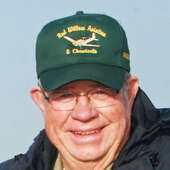- Sweatshirts, Jazzercise, and an unforgiving political climate (11/19/24)
- After the election: Lessons from history (11/5/24)
- Candy or cash: candidates and causes trick-or-treat for donations (10/29/24)
- You are fired! (10/1/24)
- Enduring heritage: Model Tís and Nebraskaís Unicam (9/24/24)
- YMCA project, coming changes and another attack (9/17/24)
- Class of '55 to share memories for Heritage Days (9/10/24)
Opinion
Graduation ... and millers
Tuesday, June 3, 2014
From 8 and 10 to 584 were the numbers of High School Seniors that Grannie and I watched graduate this spring.
The ceremonies were about equal in length but quite different in presentation. Yes, the graduates in the smaller schools received much more individual attention, but each in the large student body were appropriately announced and congratulated. Each ceremony was appropriate to the occasion with proud parents and well-wishers supporting the cast.
One small difference was that both the small schools opened the proceedings with prayer; not so at Millard West in Omaha. That event took place the day before Memorial Day so all present were invited to stand while the school orchestra proudly rendered our Star Spangled Banner.
We grandparents were a bit concerned that the handing out of that large number of diplomas would take an inordinate amount of time. It was an ill-founded concern because that school administration really had their act together. The graduates marched to the stage by seated row, each name was read from A to Z (a little tough to pronounce some of the names) a congratulatory hand shake and filed back to their seat. No big dramatic outbursts from the audience; just polite applause for each. Then at the end amid the flurry of caps tossed into the air came standing applause and cheers. It all went like clockwork at the rate of 14 graduates per minute. Of course our grandson T.J. Monzon was the star of the show in his family's eyes.
Typically at graduation a student's honors and awarding of scholarships is announced. Then again Millard West had it together by printing such facts in a very professionally assembled booklet for each guest. Obviously some of those kids had earned impressive honors. It was a proud moment for all present. Very well done.
Ah, it is miller time again here in southwestern Nebraska. Miller meaning not the brew nor the comedian but our annual invasion of the pesky miller moth. Actually the common "miller" is the adult stage of the army cutworm, Euxoa auxiliaris.
Earlier this spring, the local aerial applicators were busy spraying to prevent an invasion of army worms in growing wheat. The insecticide application most likely made a dent in the problem of the army cutworms feeding on the tender young shoots of the wheat crop but for sure they didn't make much of a dent in the overall population of their migrating brethren.
You see, what we call millers are indeed a migrating insect. Their life cycle has them migrating en masse to the higher elevation of the nearby Rocky Mountains. There at the higher elevations they summer, feeding on nectar from flowering plants.
Our pesky millers are a nocturnal animal hiding by day and flying westward by night. To hide, they crawl into small nooks and crannies in our homes, out buildings and even automobiles. If the small crack in a window casing or door leads into our home they come in to hide as unwelcome guests.
Mom with a vacuum sweeper is a good way to collect the pests and suspending a light over a pail of soapy water also works well. Left to hide in drapery, they can leave unsightly stains. They seem pretty resistant to insecticides at this stage of their life cycle.
Natural enemies include our local small birds, bless them, and in my judgment kingbirds are best of the lot in catching the millers. I love to see those yellow-bellied beauties duck, roll and dive like fighter pilots in combat. Bats feed on many as they, too, are masters of the night when most of the miller flight takes place.
Can you imagine eating one of the pests? Ugh! Thankfully our small feathered friends relish the opportunity.
It is hard to imagine, but bears, especially the American grizzly, love to eat the fuzzy pests. Picture a big old bear turning over rocks to lick up the delicacy. On banner years, the millers will collect inches deep on the ground and bears reportedly make gluttons of themselves. Yep, hard to imagine.
Millers again migrate back past us headed east in the fall. Their numbers are few due to huge summer mortality. The survivors land in weedy areas to lay eggs which hatch into baby caterpillars, known to us as cutworms, to overwinter.
The following spring, they grow into the destructive army worm larval stage and when mature, metamorph into the pupa stage.
Then they emerge as pesky miller moths we all know too well.
The cycle of life continues. It is all part of God's plan, which we humans don't seem to appreciate.
I never met a person that didn't think the fuzzy moths are anything but pests.
That is the way I saw it.
Dick Trail

